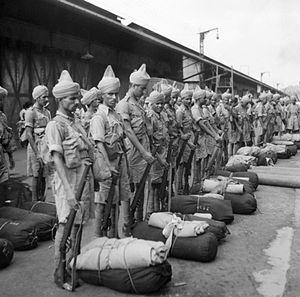Battle of Slim River
| Battle of Slim River | |||||||
|---|---|---|---|---|---|---|---|
| Part of the Battle of Malaya, World War II | |||||||
 Indian troops in Singapore, November 1941. Two Indian brigades were practically annihilated at Slim River. |
|||||||
|
|||||||
| Belligerents | |||||||
|
|
|
||||||
| Commanders and leaders | |||||||
|
|
|
||||||
| Casualties and losses | |||||||
| 500 killed 3,200 captured (Japanese estimate) |
17 killed 60 wounded (Japanese estimate) |
||||||
The Battle of Slim River occurred during the Malayan campaign in January 1942 between the Imperial Japanese Army and the British Indian Army on the west coast of Malaya.
Japanese forces had invaded north-west Malaya from southern Thailand on December 11, 1941 and eastern Malaya on December 7 at Kota Bharu. From Thailand they had driven relentlessly down the western coast of Malaya defeating all British attempts at stopping them. By Christmas Day the Japanese held all of north-west Malaya. One of the few moments where British troops managed to inflict any form of effective defense against Japanese tactics occurred near Kampar on the Dipang River. At the Battle of Kampar, in a four-day battle notable for the effectiveness of the British artillery, the Japanese suffered heavy casualties. By January 2, though, the Indian 11th Infantry Division was out flanked by seaborne landings south of the Kampar position, out numbered and with Japanese forces attempting to cut the division off from the road to Singapore, they withdrew to prepared positions at Trolak five miles north of the Slim River.
The defenses on the road to Trolak started with a four-mile corridor at the 60 mile post extending through almost impenetrable jungle to the 64 mile post, after the village the road cuts through the more open terrain of the Cluny Rubber estate for five miles before reaching the Slim River rail bridge. The road then bends east and follows the river upstream for another six miles before it crosses the Slim River at a road bridge. The British commander, Acting Major-General Paris (normally commander of the 12th Indian Infantry Brigade), had lost one of his three brigades after the fighting at Kampar; the amalgamated 5/16 Brigade, after retreating through the 12th Brigade, had been moved to a coastal defense position further south to defend the western flank of the division and to rest and reorganise. This left Paris with Lt.Col.Ian Stewart's 12th Indian Brigade and Lt.Col.Ray Selby's 28th Gurkha Brigade, both at reduced strengths due to heavy casualties in the earlier battles at Kampar and on the Grik Road, to defend the northern bank of the river.
...
Wikipedia
